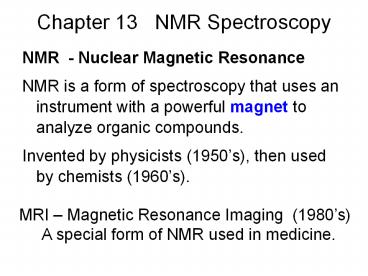Chapter 13 NMR Spectroscopy - PowerPoint PPT Presentation
Title:
Chapter 13 NMR Spectroscopy
Description:
Chapter 13 NMR Spectroscopy NMR - Nuclear Magnetic Resonance NMR is a form of spectroscopy that uses an instrument with a powerful magnet to analyze organic compounds. – PowerPoint PPT presentation
Number of Views:350
Avg rating:3.0/5.0
Title: Chapter 13 NMR Spectroscopy
1
Chapter 13 NMR Spectroscopy
- NMR - Nuclear Magnetic Resonance
- NMR is a form of spectroscopy that uses an
instrument with a powerful magnet to analyze
organic compounds. - Invented by physicists (1950s), then used by
chemists (1960s).
MRI Magnetic Resonance Imaging (1980s) A
special form of NMR used in medicine.
2
What is NMR?
- NMR a tool to determine the structure of an
organic compound.
3
Why is it called NMR?
- Nuclear Magnetic Resonance
- Nuclear because it looks at the nucleus of an
atom, most commonly a hydrogen atom. - The nucleus of a hydrogen atom consists of one
proton. It has a 1 charge and spin of ½, and
acts like a tiny bar magnet.
4
NMR Effect of Magnetic Field
No external magnetic field applied to
sample Random orientation of nuclear spins
Sample placed in an external magnetic field
Spins align with or against field (most align
with field)
5
NMR Absorption of Energy
radio waves
nucleus absorbs energy
Scan with RF field nucleus absorbs energy,
giving a signal in the NMR spectrum
Initial State nucleus at low energy level
6
NMR Information Obtained from a Spectrum
- An NMR Spectrum will generally provide three
types of information - Chemical Shift indicates the electronic
environment of the nucleus (shielded or
deshielded)
- Integration gives the relative number of nuclei
producing a given signal - Spin-Spin Coupling describes the connectivity
7
1H NMR Spectrum H2O
scanning
A sample of water is placed in an NMR instrument,
and a proton spectrum is recorded (scanned from
left to right).
An NMR signal appears. This proves thatwater
contains hydrogen atoms!
8
When does nucleus absorb energy?
Not all protons are the same!
Magnetic Fields 1. from magnet 2. from
protons 3. from electrons
External Field (Ho)from magnet
Absorption depends on shielding by electron cloud
around the nucleus. More electron density
more shielding signal shifted to the right.
9
NMR Scanning for All Nuclei
13C area is much wider
1H area is small
To see both proton and C-13 nuclei, a very wide
region would have to be scanned.
An instrument can only examine one area at a
time.
10
NMR Simple 1H NMR Spectrum Showing Chemical
Shift
Chemical Shift location of the signalon the
spectrum.
Right Sidehigh electrondensity
Left Sidelow electrondensity
Two types of protons (a CH2 and a CH3 group) give
two separate signals at two different chemical
shifts.
11
NMR Chemical Shift Practice
Cl3C-H
CH3CH3
-OCH3
EN
Group
-O-CH3 -Si-CH3 -C-CH3 Cl3C-H
3.5 1.8 2.5 3.0
Left Sidelow electrondensity(high EN)
-SiCH3
Assign the four groups shown to the four NMR
singals, based on each elements
electronegativity.
12
NMR Chemical Shift Reference
Chemical shift zero is set to TMS
(tetramethylsilane).
Chemical shift measured in ppm. For 1H roughly
0 to 10 ppm.
13
NMR Chemical Shift Regions
-O-CH3
Double Bond Region 5-10 ppm
Alkane region (high electron density) is from
about .8 2.5 ppm.
Heteroatom region (low electron density) is from
about 2.5 to 5.
Double bond region is on the left, from about 5
10 ppm.
14
NMR Chemical Equivalence and Number
of Signals
How many signals will the following compounds
show in their 1H NMR Spectrum?
(Hint check for symmetry)
2 4 5 2 4 7
15
NMR Chemical Equivalence and Number
of Signals
How many signals should appear in the proton NMR
spectrum for these compounds?
In theory 9 4 Signals
actually resolved 3-4 2
16
NMR Overlapping Proton Signals
The -CH2- groups allappear in the same spot (not
resolved)
Protons b, c, and d are in roughly the same
environment, and their chemical shifts are
also about the same.































